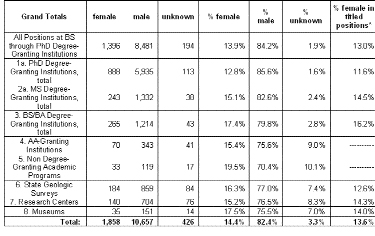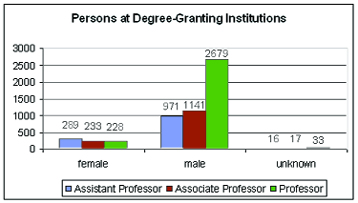Geotimes

Data Points
The Status of Women
in the Geosciences:
Women at Educational and Research
Institutions
Persons at Degree-Granting Institutions
Mary Anne Holmes, Connie Frey,
Suzanne O’Connell and Lois K. Ongley
Most geoscientists agree that gender equity is a worthy goal for our field,
but there is disagreement as to how to measure gender equity and what it actually
means. Will the geosciences achieve gender equity when the proportion of women
on our faculty and in professional positions accurately reflects the proportion
in our undergraduate classes? Or is gender equity 50 percent of all positions
in all fields, including undergraduate enrollment? By any of these measures,
we are not yet there. Women earned 40 percent of the undergraduate degrees in
geoscience (geology, oceanography, atmospheric sciences, geophysics) in 2001,
and 38 percent of all the master’s degrees — both an all-time high.
The proportion of women receiving Ph.D.s and filling professional positions
listed in the American Geological Institute’s Directory of Geoscience
Departments, however, is far behind these percentages, indicating some rather
large leaks in the pipeline for women.
Women
at Educational and Research Institutions
 Women comprise
13.6 percent of all 12,941 entries (exclusive of administrative assistants)
in the 2001 AGI Directory, with about 3 percent of entries of unknown
gender. The proportion of women varies by the type of institution, as shown
here. There is a higher proportion (but a low number) of women in museums (17.5
percent), at bachelor’s-granting academic institutions (17.4 percent),
and at non-degree-granting institutions (19.5 percent, including community colleges,
non-degree-granting programs in non-geoscience departments, etc.).
Women comprise
13.6 percent of all 12,941 entries (exclusive of administrative assistants)
in the 2001 AGI Directory, with about 3 percent of entries of unknown
gender. The proportion of women varies by the type of institution, as shown
here. There is a higher proportion (but a low number) of women in museums (17.5
percent), at bachelor’s-granting academic institutions (17.4 percent),
and at non-degree-granting institutions (19.5 percent, including community colleges,
non-degree-granting programs in non-geoscience departments, etc.).
Breakdown by gender. [*Excludes “Cooperating Faculty,” “Adjunct,”
“Other,” “Lecturer,” “Related,” “Instructor,”
“Research Associate,” and “Senior Scientist.”] Courtesy
of the authors.
However, when positions such as “cooperating faculty,” “adjunct
professor,” “lecturer” and “research associate” are
omitted, the proportion of women at every type of institution drops, reflecting
the relative concentration of women in non-tenure track positions. These proportions
have not changed significantly from data compiled by Dr. Lois Ongley four years
ago (from the 1996-1997 AGI Directory). More than half, 51 percent, of
all tenure-track positions at academic institutions in the United States are
held by men in “full professor” and/or “chair/head” positions.
One possible cause for women holding so many “cooperating” and “other”
positions at state surveys and museums is that many women at these institutions
do not have a Ph.D. degree. At museums, 43 percent of women (in all positions)
have a Ph.D. degree, while 83 percent of the men have a Ph.D. degree. Nearly
one-third of men working at state surveys hold a Ph.D. degree, while only 9
percent of women do. Twenty-one percent of men working at state surveys have
a bachelor’s degree; 38 percent of women working at state surveys have
a bachelor’s degree. Fifty-three percent of women and 59 percent of men
at Ph.D.-degree-granting institutions have tenure-track positions. A higher
proportion of women work in non-tenure leading positions than in tenure-track
positions.
Persons
at Degree-Granting Institutions
 At degree-granting
institutions, the proportion of women in faculty positions varies by rank. Most
women are in “assistant professor” positions (39 percent), and next
“associate professor” positions (31 percent). There is a slightly
higher proportion of women in administrative positions than in “full professor”
positions (7.8 percent). Almost 60 percent of men are in “full professor”
or “chair/head” positions. Only 30 women professors in the geosciences
in the United States have emeritus status, while 1062 males hold emeritus status.
At degree-granting
institutions, the proportion of women in faculty positions varies by rank. Most
women are in “assistant professor” positions (39 percent), and next
“associate professor” positions (31 percent). There is a slightly
higher proportion of women in administrative positions than in “full professor”
positions (7.8 percent). Almost 60 percent of men are in “full professor”
or “chair/head” positions. Only 30 women professors in the geosciences
in the United States have emeritus status, while 1062 males hold emeritus status.
Holmes is a research associate
professor in the Geosciences Department at the University of Nebraska-Lincoln
and former president of the Association for Women Geoscientists. Frey is ABD in
sociology and an associate with the University of Nebraska-Lincoln Bureau of Sociological
Research. O’Connell is an associate professor in the Department of Earth
and Environmental Sciences at Wesleyan University, Middletown, Conn. E-mail: soconnell@wesleyan.edu.
Ongley is a chemistry teacher at Oak Hill High School in Wales, Maine, and president
of the Androscoggin Valley Environmental Center.
This study was funded by the National Science Foundation. Thanks to Nick Claudy
of AGI for providing us with electronic copies of the AGI Directory. Krystal Pearson
and Stephanie Day helped us identify gender for nearly 2,600 “gender-unspecified”
entries.
Back to top
 Women comprise
13.6 percent of all 12,941 entries (exclusive of administrative assistants)
in the 2001 AGI Directory, with about 3 percent of entries of unknown
gender. The proportion of women varies by the type of institution, as shown
here. There is a higher proportion (but a low number) of women in museums (17.5
percent), at bachelor’s-granting academic institutions (17.4 percent),
and at non-degree-granting institutions (19.5 percent, including community colleges,
non-degree-granting programs in non-geoscience departments, etc.).
Women comprise
13.6 percent of all 12,941 entries (exclusive of administrative assistants)
in the 2001 AGI Directory, with about 3 percent of entries of unknown
gender. The proportion of women varies by the type of institution, as shown
here. There is a higher proportion (but a low number) of women in museums (17.5
percent), at bachelor’s-granting academic institutions (17.4 percent),
and at non-degree-granting institutions (19.5 percent, including community colleges,
non-degree-granting programs in non-geoscience departments, etc.).
 At degree-granting
institutions, the proportion of women in faculty positions varies by rank. Most
women are in “assistant professor” positions (39 percent), and next
“associate professor” positions (31 percent). There is a slightly
higher proportion of women in administrative positions than in “full professor”
positions (7.8 percent). Almost 60 percent of men are in “full professor”
or “chair/head” positions. Only 30 women professors in the geosciences
in the United States have emeritus status, while 1062 males hold emeritus status.
At degree-granting
institutions, the proportion of women in faculty positions varies by rank. Most
women are in “assistant professor” positions (39 percent), and next
“associate professor” positions (31 percent). There is a slightly
higher proportion of women in administrative positions than in “full professor”
positions (7.8 percent). Almost 60 percent of men are in “full professor”
or “chair/head” positions. Only 30 women professors in the geosciences
in the United States have emeritus status, while 1062 males hold emeritus status.
